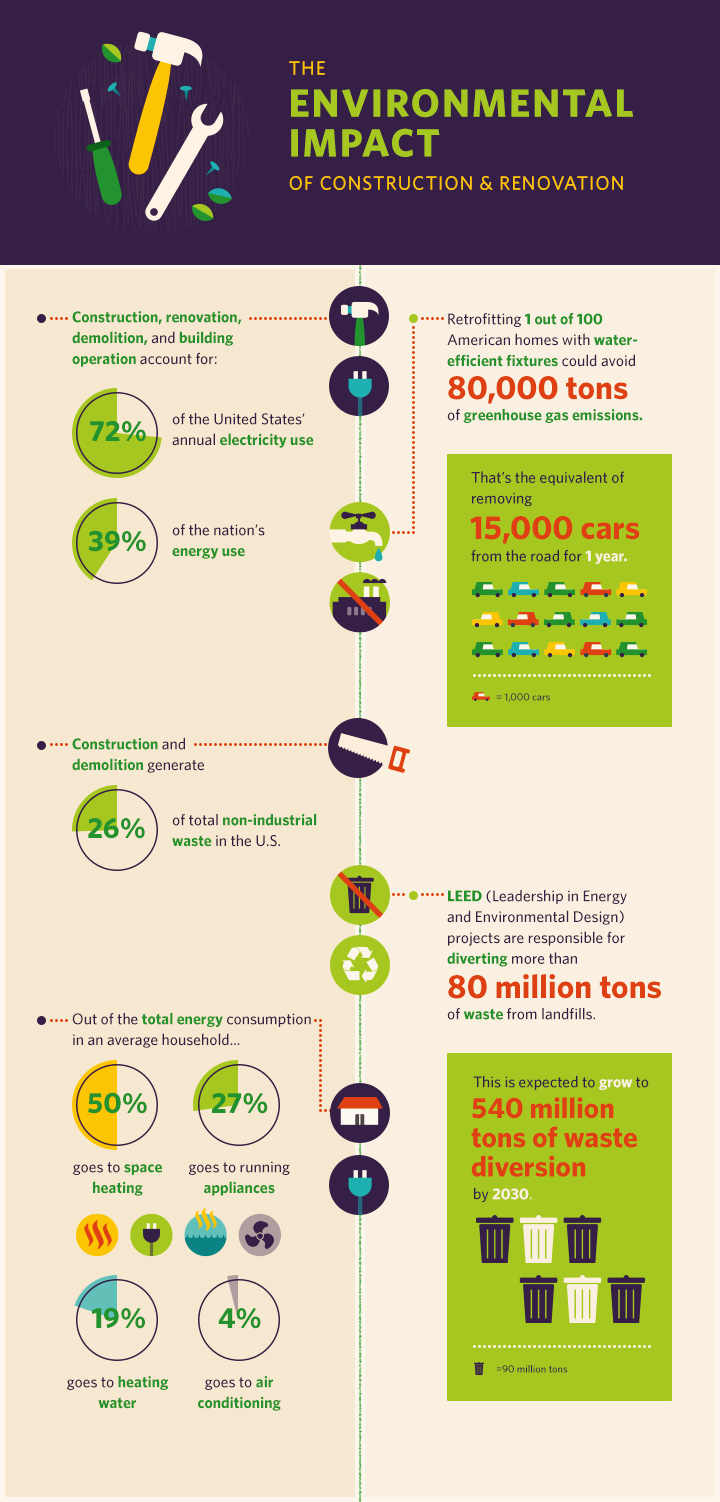The kitchen is a bustling place in most homes: Meals are made, conversations happen, and days are planned. That’s probably why it’s one of the most popular rooms to renovate according to The National Association of Home Builders. And with the improving economy, both remodeling and new home building and are surging.
Choosing to build or remodel with sustainably in mind can help families reduce their carbon footprint and create a healthier home. Home energy accounts for 19 percent of a family’s total environmental impact, and the kitchen uses a large portion of energy in most homes, as well as a sizable amount of water. By selecting the right eco-friendly materials, low-flow faucets, and efficient appliances, a family can reduce energy use and utility costs. As an added bonus, avoiding the use of toxic chemicals in the construction process can improve indoor air quality.
A new kitchen also offers an opportunity to design a more sustainable lifestyle. The choices we make in our kitchens—whether it’s ordering takeout or tossing together a salad with veggies from the farmers’ market—make a huge impact on the health of agricultural systems and wider ecosystems. Food actually accounts for a bigger portion of our ecological impact than home energy. The ultimate sustainable kitchen is one that encourages green living beyond just counter materials and appliances, and it all starts during the design phase.
Design for Sustainability
-
Remember, size matters.
Bigger is not always better, especially when it comes to sustainability. Smaller spaces require fewer building materials and less energy to heat and cool. A smart layout with wise use of cabinets and countertops can make the most of a smaller kitchen.
-
Think timeless.
The key to a sustainable building project is to create something durable because most construction projects require resources and energy for execution. Careful planning before breaking ground can prevent the need for a move or later renovations. Consider your home’s future. What will the family need in five to ten years? Will an aging family member require special accommodations? Assess the durability of every material. It doesn’t matter how green something is if it has to be ripped out in a couple of years. And try to keep decor as fresh as possible by choosing classic styles. Don’t get stuck with the avocado green appliances and paisley wallpaper of tomorrow.
-
Plan for natural lighting and ventilation.
Windows and skylights can minimize the need for artificial lighting, passively heat a room, provide ventilation, and improve air quality. But plan wisely, or they’ll drain heat and energy in the winter and make a room scorching hot in the summer. South-facing skylights provide the greatest potential for passive heating, but often allow unwanted heat gain in the summer. To prevent excessive summer heat, install skylights iundern the shade of deciduous trees or add movable coverings or a special glaze, and carefully consider the placement of windows and awnings. Another way to create more natural light in a kitchen is to create an open floor plan.
-
Construct a lifestyle.
Even the greenest architecture and appliances won’t counteract a wasteful lifestyle. Incorporate aspects of green living right into the plans to make a sustainable lifestyle even easier.
-
Design a kitchen garden.
During the Renaissance, the French built potagers, or kitchen gardens, which provided food and herbs for households year-round. Kitchen gardens were designed to be low maintenance and aesthetically beautiful, with lots of edible perennials. Even small vegetable gardens or herb patches help a family connect with nature and eat healthier—the closer to the kitchen, the better.
-
Create an indoor growing station.
No outdoor growing area to admire from the kitchen window? Create an indoor herb or vegetable growing station in a sunny window. Most edible plants require six hours of light daily, either from sunlight or a grow light. Many plants, such as lettuce, celery, ginger, potatoes, bean sprouts, garlic, and onions, can be grown from kitchen scraps. Bonus: Indoor plants help improve air quality.
-
Build a composting system.
Each person can prevent 140 pounds of waste from going into landfills each year by composting. That’s important for many reasons, but mainly because food waste breaks down in landfills and produces methane, a greenhouse gas. Composting turns kitchen scraps into compost, further reducing the need for fertilizer, pesticides, and water. Build a compost bin outside and keep a container next to the sink to collect scraps, or tuck a homemade compost or worm bin under the sink.
-
Plan for food preservation.
Local food is most sustainable, but many of us don’t have the space or tools to store 20 pounds of pears when they’re ripe at the farmer’s market, or a season’s worth of homemade tomato sauce. By incorporating a pantry, dehydrator, efficient freezer, or other food preservation tools into new kitchen plans, a family can take advantage of local and sustainable food options.
Choose eco-friendly materials
Once a design is in place, it’s time to choose the most sustainable building materials, which will vary depending on location and project. Life Cycle Assessment software can help consumers assess how materials are processed, how far they must be shipped, how long they’ll last, and whether they can be recycled. The results may be surprising. For instance, bamboo grows quickly, and is considered more renewable than slow-growing hardwood. However, using sustainably harvested, locally milled wood from domestic trees is more sustainable than shipping in bamboo from China.
Reclaiming or salvaging existing materials is the most sustainable and often the most economical option. Check local salvage yards and building materials exchanges first for desired materials.
When choosing manufactured materials, consider how they will effect indoor air quality. Volatile organic chemicals (VOCs) used in building materials, furniture, adhesives, paints, and varnishes off-gas for years and can cause adverse health effects. The World Health Organization warns that 30 percent of new or recently renovated buildings give inhabitants “sick building syndrome” or “building-related illness.” To keep indoor air healthy, avoid products with formaldehyde and other carcinogenic substances, and look for materials labelled low- or zero-VOC.
It’s a good idea to check out resources naturally abundant in the region first. Beyond that, some materials tend to be more eco-friendly than others.
Countertops
Granite countertops are trendy, but most are made from rock mined in ecologically devastating ways and shipped across the world. They also tend to have cracks and fissures that are prone to contamination from bacteria. Instead consider:
- Concrete (made with fly ash or recycled waste products)
- Recycled paper
- Recycled glass
- Wood
Cabinets
Environmental Stewardship Program (ESP) certification helps consumers find cabinet manufacturers that use recycled materials and limit formaldehyde emissions. Look for the Forest Stewardship Council (FSC) stamp of approval for wood harvested in a sustainable way.
Flooring
Kitchen floors get lots of wear and tear, so durability is of primary importance. Options to consider:
- Linoleum
- Tile made from recycled materials
- Salvaged or reclaimed wood
- Domestic hardwood (Domestic trees are often milled in Asia; look for products grown and milled in the U.S.)
- Bamboo (Many products are FSC-certified and low-VOC. Research thoroughly; depending on how it’s manufactured, bamboo can be prone to dents and scratches. Also, bamboo is imported from China, so it often has a higher carbon footprint than other options.)
Lighting
Natural daylight should be optimized in the design. For evening lighting, install task lighting in key work areas to prevent the need for lighting an entire space all the time. Consider occupancy sensors, timers, and dimmers to make energy saving automatic. And look for Energy Star-rated, shatter-resistant, compact fluorescent light bulbs or LEDs.
Paint
Conventional latex and oil-based paints are known to cause nausea, dizziness, and headaches, and be carcinogenic. Moreover, conventional paint is a hazardous waste product that must be disposed of properly. Low- and zero- VOC paints are readily available and a better alternative than conventional paint. Biodegradable natural paints free of chemical ingredients are best.
Go Efficient with Appliances
The Environmental Protection Agency estimates homeowners can save more than $100 a year in energy costs by simply replacing a refrigerator made before 1992 with an energy efficient model. All new appliances now have an EnergyGuide label to help consumers compare the typical annual energy consumption and operating cost of different models. Look for the Energy Star® rating to find the most efficient models. (Smaller models tend to be most efficient.) Be sure to think long term when shopping. Major appliances usually last between 10 and 20 years, and lower utility bills over their lifetime can offset a higher purchase price. Resell old appliances, or donate them to a thrift store or recycling center.
Start Planning
The ultimate sustainable kitchen is one that a family loves, because it’s the one they’ll be happy with for years to come.
If this article has you considering a more sustainable lifestyle, check out these kitchen pantry ideas — http://www.custommade.com/gallery/custom-pantries/









